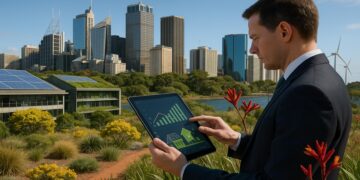The future of work and its economic implications in Australia

Understanding the Shifting Landscape of Work in Australia
The way Australians approach work is undergoing a profound transformation, largely driven by advancements in technology and the evolving expectations of society. Recognizing these changes and their implications is vital, not only for individuals seeking sustainable careers but also for businesses and policymakers striving to adapt to a dynamic economic climate.
Several factors are at the forefront of this evolution:
- Automation and AI: The integration of automation and artificial intelligence is reshaping many industries. For example, in sectors like manufacturing, robots can now perform tasks that once required human labor, leading to increased efficiency but also job displacement in certain areas. Work previously performed by humans is being complemented by machines, and this alteration requires workers to acquire new skills to remain relevant in a changing job market.
- Remote Work: The surge in remote work options, accelerated by the COVID-19 pandemic, has changed traditional workplace structures. Employees are now enjoying flexible working conditions that allow them to balance professional and personal lives more effectively. This shift has had far-reaching implications, such as the decline in demand for office space in major urban centers, as many professionals opt to live in rural or suburban areas where living costs are lower.
- Gig Economy: The gig economy is gaining traction, with a growing number of Australians pursuing freelance or contract work. Platforms such as Uber and Fiverr allow individuals to capitalise on their skills without committing to a traditional full-time job. This trend not only offers more autonomy in how people work but also poses challenges in terms of income stability and access to benefits commonly associated with permanent employment.
The implications of these changes are noteworthy. For instance, the rise in remote work may alter urban planning, reflecting a growing need for housing that accommodates telecommuting lifestyles. As a result, suburban areas are experiencing growth, leading to changes in infrastructure development and local economies.
Moreover, consumer spending patterns are shifting; individuals who move away from cities to more affordable areas might spend differently, favouring local businesses and services. This could stimulate growth in small towns and communities that were previously overlooked.
It is also essential to consider the psychological aspects of these transitions. As professionals work from home, they may experience feelings of isolation, impacting their mental health and community involvement. Social connections traditionally formed in office environments are being disrupted, which can affect overall well-being and engagement.
In light of these changes, it is imperative for policymakers, businesses, and individuals to remain vigilant and informed about ongoing trends. By understanding the complexities of this new economic reality, Australia can work towards fostering an inclusive and sustainable workforce that meets the needs and challenges of the future.
Technological Advancements and Job Market Dynamics
As we delve deeper into the economic implications of the changing work landscape in Australia, it becomes clear that technological advancements are at the centre of this transformation. The rapid pace of innovation is not merely reshaping how we work; it is also redefining the types of jobs available and the skills required to perform them effectively. This shift brings both opportunities and challenges that must be acknowledged.
One of the most significant trends to watch is the impact of automation on employment. While it is true that automation enhances productivity, it often leads to job displacement, particularly in low-skilled positions. For example, roles in data entry, retail, and assembly lines may become obsolete as businesses increasingly adopt automated systems. According to a report by the Australian Workforce and Productivity Agency, up to 40% of current jobs may be vulnerable to automation in the next couple of decades. This statistic highlights the need for a proactive approach in reskilling the workforce.
To respond to these changes, several key areas must be prioritized:
- Investment in Education and Training: Educational institutions and vocational training programs must adapt to include emerging technologies and skills such as coding, data analysis, and digital marketing. By equipping the workforce with necessary tools, Australia can mitigate the risk of unemployment due to automation.
- Promoting Lifelong Learning: Workers should embrace the concept of lifelong learning, continuously updating their skill set throughout their careers. This mindset encourages adaptability and can safeguard against future job displacement.
- Industry Collaboration: Businesses, government, and educational institutions must collaborate to ensure that training programs align with market needs. By fostering partnerships, stakeholders can create effective pathways from education to employment.
Beyond education, the proliferation of technology has also led to the emergence of new job categories that were previously unheard of. For instance, roles in social media management, app development, and cybersecurity are now in high demand. These jobs not only require specific skill sets but also often offer the potential for flexible working conditions, aligning with the growing trend of remote work.
The economic implications of these transformations are profound. As certain industries shrink due to automation, others flourish, leading to a reallocation of labor and resources. This shift requires ongoing analysis and policy adjustments to support affected workers and stimulate sectoral growth. Moreover, there is a pressing need for local governments to understand these dynamics. A focus on entrepreneurship and innovation can bolster economic resilience, creating new opportunities in emerging fields.
In sum, the future of work in Australia will be shaped by a combination of technological advancements and social adaptability. Embracing continuous learning and fostering collaboration between educational institutions and industries is vital. As we navigate these changes, it is crucial to prioritize inclusive strategies that empower all Australians to participate fully in the evolving economic landscape.
Changing Workforce Demographics and Flexibility in Employment
In addition to technological advancements, the economic landscape of Australia is also being influenced by changing workforce demographics. As the country’s population evolves, so too do the expectations of workers. The increasing number of millennials and Generation Z entering the workforce comes with distinct preferences that challenge traditional employment practices. These newer generations place a strong emphasis on work-life balance, meaningful work, and opportunities for personal growth, significantly altering the employer-employee relationship.
One of the most notable shifts is the rise of flexible working arrangements. Remote working or hybrid models are no longer fringe options; they have become the expectation for many workers. A recent survey found that over 60% of Australian employees prefer flexible work schedules. This has prompted companies to rethink their workplace strategies, focusing on outcomes rather than hours spent in the office. Implementing remote work policies and providing the necessary technology for communication and collaboration can yield significant benefits for businesses, including higher employee satisfaction and retention rates.
Furthermore, these changes necessitate a reevaluation of office spaces. Many companies are transitioning to co-working environments or reducing office footprints, further transforming the commercial real estate market. The financial implications are profound, as businesses balance cost savings with the need to create engaging spaces that attract talent. As hybrid work models gain traction, it will also be crucial for organizations to invest in robust cybersecurity measures to protect data, particularly in a remote working context.
Diversity and inclusion are also central themes in the evolving workforce landscape. Companies are increasingly recognizing the value of diverse perspectives, which not only foster innovation but also enhance team dynamics. This shift toward inclusivity means that employers are expected to create environments where all employees can thrive and contribute their unique talents. As research has shown, companies that embrace diversity tend to outperform their competitors financially, making a compelling case for economic growth through inclusion.
To attract and retain a diverse workforce, employers will need to implement targeted strategies, such as mentorship programs, training sessions that focus on bias awareness, and establishing clear pathways for career advancement. These initiatives not only aid in economic development but also enhance workplace culture, making firms more resilient to market changes.
Additionally, the gig economy continues to expand, offering new avenues for employment and income. With platforms for freelancing in creative fields, ridesharing, and temporary roles on the rise, many Australians are opting for non-traditional work arrangements. This flexibility can be appealing; however, it also raises questions about job security, worker rights, and access to benefits traditionally associated with full-time employment, such as sick leave and superannuation. The government faces a challenge to create policies that protect these workers while still fostering a dynamic job market.
In essence, the future of work in Australia is shaped by a blend of demographic changes, evolving workplace expectations, and the rise of diverse work arrangements. By adapting to these trends, businesses can harness the potential of a flexible and diverse workforce, leading to widespread economic benefits. The implications of these shifts are vast, affecting everything from employee satisfaction to national productivity levels.
Conclusion
As we examine the future of work in Australia, it is clear that transformative trends—from technological advancements to shifting workforce demographics—are reshaping the economic landscape. The increasing preference for flexible working arrangements reflects a deeper cultural shift toward prioritising work-life balance and employee wellbeing. This trend not only enhances job satisfaction but also boosts productivity, creating a positive feedback loop that can drive economic growth.
Moreover, the rise of diversity and inclusion within workplaces highlights the importance of varied perspectives and innovation. Companies that embrace diversity often see improved performance, suggesting that inclusivity is not just a moral imperative but a smart economic strategy. To thrive in this new environment, businesses must remain committed to fostering diverse talent while also adapting to the unique needs of a changing workforce.
Additionally, as the gig economy continues to flourish, policymakers face the challenge of ensuring fair worker protections while promoting a fluid job market. It is essential for the Australian government to implement supportive frameworks that include access to benefits for gig workers, striking a balance between flexibility and security.
In conclusion, the future of work presents both opportunities and challenges for Australia. By embracing change and fostering a dynamic, inclusive workforce, Australian businesses can not only adapt to these emerging trends but also contribute to a robust economy that benefits all. As we move forward, the focus should remain on creating sustainable workplaces that support innovation and individual growth, ultimately leading to a prosperous future for the nation.

James Carter is a financial writer and advisor with expertise in economics, personal finance, and investment strategies. With years of experience helping individuals and businesses make complex financial decisions, James offers practical insight and analysis. His goal is to give readers the knowledge they need to achieve financial success.






